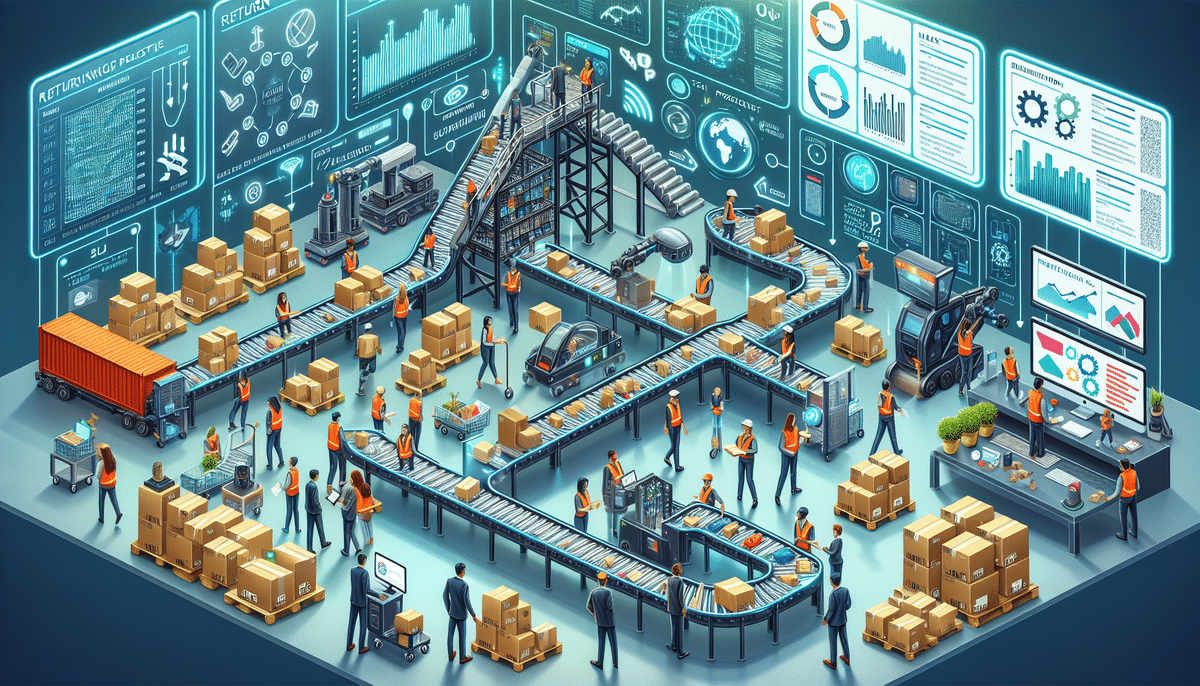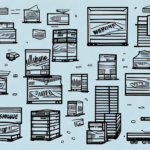Understanding Reverse Logistics in E-Commerce
E-commerce has completely revolutionized the way we shop. With the click of a button, consumers can have almost anything delivered to their doorstep. However, this incredible convenience comes with a significant challenge: returns. It’s estimated that up to 30% of online purchases are returned, compared to just 9% for brick-and-mortar stores (National Retail Federation). This is where reverse logistics plays a crucial role.
What is Reverse Logistics?
Reverse logistics refers to the process of managing the flow of goods that are returned by customers. This includes handling returns, repairs, recycling, and disposal. E-commerce retailers face unique challenges in reverse logistics, as products may need to be returned from all over the world, and the process must be both efficient and cost-effective.
One of the biggest challenges in reverse logistics for e-commerce retailers is managing the condition of returned products. Unlike traditional brick-and-mortar stores, e-commerce retailers cannot physically inspect the product before purchase. This means that returned products may be damaged, used, or missing parts. E-commerce retailers must have a system in place to quickly assess the condition of returned products and determine whether they can be resold, refurbished, or must be disposed of.
The Importance and Benefits of Reverse Logistics
Effective reverse logistics can provide a major competitive advantage for e-commerce retailers. Not only can it reduce costs and increase customer satisfaction and loyalty, but it can also help to reduce waste and benefit the environment.
Reverse logistics involves managing products that are returned by customers. This process can be complex and costly, but it is essential for e-commerce retailers to handle returns efficiently and effectively. By implementing a streamlined reverse logistics process, retailers can minimize the time and resources required to process returns while ensuring that returned products are properly disposed of or resold. This can help reduce waste and benefit the environment, while also improving the bottom line for retailers.
Enhancing Customer Satisfaction
A seamless returns process enhances customer satisfaction and loyalty. According to a Bain & Company report, companies that excel in customer experience can see revenue growth up to 10% higher than their competitors. An efficient reverse logistics system ensures that customers have a hassle-free experience when returning products, which can lead to repeat business and positive reviews.
Environmental Impact
Reverse logistics also plays a vital role in sustainability efforts. By recycling and repurposing returned products, e-commerce retailers can significantly reduce their environmental footprint. The United Nations Environment Programme highlights the importance of sustainable logistics in reducing waste and conserving resources.
Key Elements of Effective Reverse Logistics
To implement effective reverse logistics, e-commerce retailers must understand the key elements involved. This includes everything from the physical handling of returns to the management of data and costs.
Efficient Communication
Efficient communication between the retailer and the customer is essential. This includes providing clear instructions for the return process and timely updates on the status of the return. Clear communication helps set customer expectations and reduces confusion, leading to a smoother returns process.
Tracking and Data Management
Retailers must have a robust system in place for tracking returned items. Effective tracking ensures that returned products are properly processed and either resold or disposed of in an environmentally responsible manner. Utilizing data management systems allows retailers to analyze return patterns and improve their processes accordingly.
Cost Management
Managing the costs associated with reverse logistics is crucial. Retailers need to find a balance between offering convenient return options for customers and controlling the expenses involved in processing returns. Strategies such as centralized return centers and partnering with third-party logistics providers can help manage costs effectively.
The Role of Technology in Reverse Logistics
Technology plays a critical role in streamlining the reverse logistics process. E-commerce retailers can leverage a suite of software solutions, ranging from inventory management systems to artificial intelligence, to ensure that returns are handled efficiently and cost-effectively.
Inventory Management Systems
Inventory management systems help retailers keep track of returned products in real-time. By integrating these systems with their e-commerce platforms, retailers can gain better visibility into their inventory levels and make informed decisions about reselling or refurbishing returned items.
Artificial Intelligence and Predictive Analytics
Artificial intelligence (AI) and predictive analytics can help retailers anticipate return rates and identify patterns in customer behavior. According to a study by McKinsey & Company, AI can enhance demand forecasting and inventory optimization, reducing the likelihood of excess returns.
Blockchain for Transparency
Blockchain technology can provide transparency and traceability in the reverse logistics process. By recording every step of the return journey on a decentralized ledger, retailers can ensure the authenticity and condition of returned products, reducing fraud and improving accountability.
Best Practices and Strategies for Reverse Logistics
Implementing effective reverse logistics requires a carefully planned strategy. This includes improving the returns process and ensuring effective communication with customers. E-commerce retailers can also leverage various tactics, such as incentivizing returns and offering alternative options like exchanges or store credit.
Incentivizing Returns
Offering incentives for returns can help manage the volume and cost of returns. For example, providing customers with return shipping discounts or loyalty points can encourage returns that are more manageable for the retailer, while still maintaining customer satisfaction.
Alternative Return Options
Providing multiple return options, such as exchanges, store credit, or in-store returns, can offer flexibility to customers and reduce the operational burden on retailers. This approach can enhance the customer experience and increase the likelihood of repeat business.
Analyzing Return Data
By analyzing return data, retailers can identify common reasons for returns and take proactive measures to address them. For instance, if a particular product has a high return rate due to sizing issues, the retailer can adjust the product descriptions or sizing guidelines to reduce future returns.
Overcoming Challenges in Reverse Logistics
While there are many benefits to effective reverse logistics, there are also numerous challenges and obstacles that must be addressed. These include ensuring the security of returned products and managing the cost of returns. However, with careful planning and a commitment to continual improvement, e-commerce retailers can overcome these challenges and reap the rewards of a streamlined reverse logistics process.
Managing Product Condition
One of the biggest challenges is the condition of returned products. Returned items may be damaged, used, or missing components, making them difficult to resell. To address this, retailers can implement strict return policies and procedures, including thorough inspections of returned products and clear communication with customers about the condition of their returns.
Fraud Prevention
Return fraud is a significant issue in reverse logistics. Retailers can mitigate this risk by using advanced tracking systems and validating return requests through multiple verification steps. Implementing machine learning algorithms to detect suspicious return patterns can also help reduce fraud.
Sustainability and Waste Management
Proper disposal of non-resellable items is essential to minimize environmental impact. Retailers can partner with recycling organizations or invest in refurbishment facilities to ensure that returned products are handled responsibly.
Financial and Environmental Benefits of Effective Reverse Logistics
Effective reverse logistics can significantly impact the bottom line of e-commerce retailers. By reducing costs associated with returns and improving the overall efficiency of the supply chain, retailers can see direct financial benefits.
Cost Reduction
By implementing processes to quickly and efficiently handle returns, retailers can reduce labor costs and minimize the financial impact of excess inventory. Centralized return centers and partnerships with third-party logistics providers can help achieve these cost savings.
Value Recovery
Retailers can recover value from returned products through refurbishment, repackaging, and reselling as open-box items. According to a report by Deloitte, value recovery from returns can lead to significant revenue streams and enhance overall profitability.
Environmental Sustainability
By recycling and repurposing returned products, retailers can reduce waste and lower their environmental footprint. Implementing sustainable practices in reverse logistics not only benefits the environment but also appeals to eco-conscious consumers, enhancing the brand’s reputation.
Case Studies: Successful Reverse Logistics in E-Commerce
Many companies have successfully implemented reverse logistics in e-commerce. Amazon and Zappos have leveraged innovative strategies and technology to streamline their returns process and improve customer satisfaction. By studying these successful companies, e-commerce retailers can gain valuable insights into implementing their own effective reverse logistics processes.
Amazon's Efficient Returns System
Amazon has developed a highly efficient returns system that allows customers to return items with minimal hassle. By utilizing automation and advanced tracking technologies, Amazon can process returns quickly, ensuring that returned items are either resold or recycled efficiently.
Nordstrom's Local Returns
Nordstrom has implemented a program called "Nordstrom Local," which allows customers to return items at any Nordstrom location, regardless of where the item was originally purchased. This flexibility has improved the returns process for customers and increased foot traffic to Nordstrom stores.
Best Buy's Renew Blue Program
Best Buy has implemented a program called "Renew Blue," which focuses on refurbishing and reselling returned electronics. This initiative has not only reduced waste and improved sustainability but also generated additional revenue for the company.
Future Trends and Innovations in Reverse Logistics
The world of e-commerce is constantly evolving, and so is reverse logistics. Emerging technologies like blockchain and the Internet of Things (IoT) are being leveraged to improve the efficiency and sustainability of reverse logistics. As these trends continue to evolve, e-commerce retailers that prioritize their reverse logistics process will be the ones that ultimately succeed in the marketplace.
Artificial Intelligence and Machine Learning
One of the most promising future trends is the use of artificial intelligence (AI) in reverse logistics. AI can help retailers predict which products are more likely to be returned, allowing them to take proactive measures to prevent those returns from happening in the first place. Additionally, AI can help retailers better understand why products are being returned, enabling them to make improvements to their products and processes to reduce future returns.
Blockchain for Enhanced Transparency
Blockchain technology can provide enhanced transparency and traceability in the reverse logistics process. By maintaining a decentralized and immutable ledger, retailers can ensure the authenticity and condition of returned products, reducing fraud and improving accountability.
Internet of Things (IoT) Integration
The integration of IoT devices can offer real-time tracking and monitoring of returned goods. Sensors can provide data on the condition and location of returned items, enabling retailers to make informed decisions about the handling and processing of these products.
Conclusion
Implementing effective reverse logistics in e-commerce is essential for reducing costs, enhancing customer satisfaction, and promoting sustainability. By leveraging technology, adopting best practices, and learning from successful case studies, e-commerce retailers can create a robust reverse logistics system that drives business success and environmental responsibility.




















